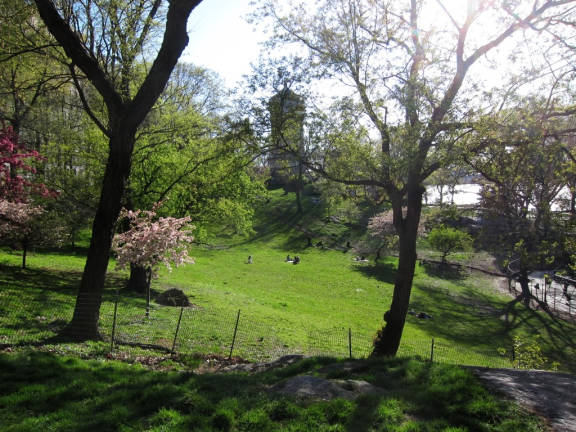Robert Moses, Park Builder Op-Ed

Last Labor Day, I discovered a unique pathway in Riverside Park – a park I have explored for 40 years.
Entering on W. 83rd Street, south of Mount Tom, I walked north along a narrow tree-lined dirt path adjacent to the promenade. Riverside Drive was to the east, and the Hudson River on my left. As I meandered, I wondered how far this unplanned path went. Two joggers and a dog walker passed me on the trail, which wound through stately trees. Dogs barked from a dog run. Around 91st Street, I dawdled on the mall near the beautiful flowers and shrubs created by the Garden People.
Crossing 95th Street, I re-entered Riverside Park where the foot path continued west of the playground and then onto a wooded area. Near the 105th Street dog run, a jogger nodded to me. Suddenly a train whistle blew from an Amtrak train passing underneath my feet and I realized a man-made platform covering railroad tracks was beneath me. An enormous concrete and steel cage structure was built by Robert Moses and his fellow workers in the 1930’s. They decked over the smoky, smelly freight route from 72nd to 123rd Streets, and they added about 130 acres to Riverside Park. Moses also built hundreds of playgrounds, playing fields and the 79th Street Marina in Riverside Park during his time as NYC Parks Commissioner. Though he built more parks in all the boroughs than anyone else, Moses had a special affection for Riverside Park.
I continued along the winding dirt path in an area with large trees until 119th street, where tennis courts blocked the way.
By contrast, 200 yards west of this path lies the “Cherry Walk” along the Hudson River. It now is a paved road, a section of the Manhattan Greenway and the Batt-To-Bear Trail. Bikers whiz close by often-frightened pedestrians. Local walkers avoid this bike speedway on weekends. Despite the bikers, The Shorewalkers, a walking and environmental group, take the Cherry Walk route on their Great Saunter Around Manhattan’s Rim on the first Saturday in May.
Along with fellow Shorewalker Chris, I scouted the Robert Moses Foot Path north of 119th Street. Veering west of the tennis courts we walked along the narrow tree-branch covered path until we reached an overgrown, un-manicured open field with a patch of bright, yellow flowers. To the west a great view of he Hudson estuary. East of the field we see an unkempt tangle of trees and shrubs sloping sharply up to Riverside Drive.
Above this “forever wild” part of the park, we glimpsed the top of Grant’s Tomb. Approaching the Harlem waterfront, the Robert Moses Foot Path dips down towards the 125th Street valley, following the contours of hilly Manahatta. Keeping close to the ramp from the highway, but not on it, we encountered a few fallen branches. The RMFP ends at 129th Street near the elegant giant, steel viaduct arches supporting Riverside Drive. We walked under a viaduct to a nearby tavern for food and beer.
This two-plus-mile-long foot path created inadvertently by walkers and joggers should be preserved as a quiet, meandering walkway. Let’s keep it that way. And let’s name it after New York’s greatest park building genius: Robert Moses, who built more green parks, more beaches, more playgrounds, and more swimming pools for New Yorkers than anyone else. Let’s keep wheeled vehicles off this path forever.
Robert Moses didn’t plan the narrow dirt path on which we walked, but it wouldn’t be here if he hadn’t covered the railroad track and built the massive train tunnel. Moses was sometimes arrogant, difficult, and stubborn. So what? New Yorkers who love parks, and especially Riverside Park, owe Moses a great deal. This desire path/walkway should bear his name and be called The Robert Moses Foot Path.
Cy A. Adler is the author of “Walking Manhattan’s Rim- the Great Saunter; Walking the Hudson, Batt To Bear-From The Battery To Bear Mountain, etc.”